LOS 33 GRADOS DEL RITO ESCOCES ANTIGUO Y ACEPTADO
Página 1 de 1.
 LOS 33 GRADOS DEL RITO ESCOCES ANTIGUO Y ACEPTADO
LOS 33 GRADOS DEL RITO ESCOCES ANTIGUO Y ACEPTADO
Masonic Symbols: 33 Degrees of The Ancient and Accepted Scottish Rite of Freemasonry.  The fraternity is administratively organized into independent Grand Lodges or sometimes Orients, each of which governs its own jurisdiction, which consists of subordinate (or constituent) Lodges. The various Grand Lodges recognize each other, or not, based upon adherence to landmarks. There are also appending bodies, which are organizations related to the main branch of Freemasonry, but with their own independent administration. There is no degree in Freemasonry higher than that of Master Mason, the Third Degree. There are, however, a number of organizations that require being a Master Mason as a prerequisite for membership. These bodies have no authority over the Craft. These orders or degrees may be described as additional or appendant, and often provide a further perspective on some of the allegorical, moral and philosophical content of Freemasonry. The Ancient and Accepted Scottish Rite of Freemasonry, commonly known as simply the Scottish Rite, is one of several Rites of the worldwide fraternity. A Rite is a series of progressive degrees that are conferred by various Masonic organizations or bodies, each of which operates under the control of its own central authority. In the Scottish Rite the central authority is called a Supreme Council. The thirty-three degrees of the Scottish Rite are conferred by several controlling bodies. The first of these is the Craft Lodge which confers the Entered Apprentice, Fellowcraft, and Master Mason degrees. Craft lodges operate under the authority of Grand Lodges, not the Scottish Rite. Although most lodges throughout the English-speaking world do not confer the Scottish Rite versions of the first three degrees, there are a handful of lodges in New Orleans and in several other major cities that have traditionally conferred the Scottish Rite version of these degrees. The Scottish Rite is one of the appendant bodies of Freemasonry that a Master Mason may join for further exposure to the principles of Freemasonry. In England and some other countries, while the Scottish Rite is not accorded official recognition by the Grand Lodge, there is no prohibition against a Freemason electing to join it. In the United States, however, the Scottish Rite is officially recognized by Grand Lodges as an extension of the degrees of Freemasonry. The Scottish Rite builds upon the ethical teachings and philosophy offered in the craft lodge, or Blue Lodge, through dramatic presentation of the individual degrees. 3rd Degree: Master Mason 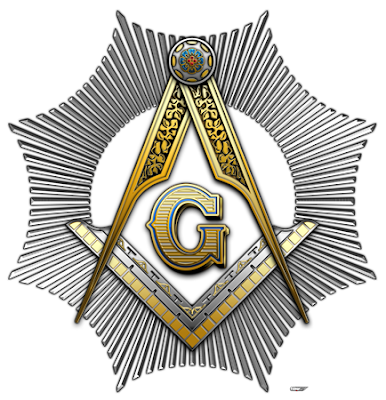 The Square and Compass or sometimes known as “The Light” is also representative of the 3rd degree in a Freemason’s level of achievement. Once a mason has reached the 3rd degree, he becomes a Master Mason. Both the square and compasses are architect's tools and are used in Masonic ritual as emblems to teach symbolic lessons. Some Lodges and rituals explain these symbols as lessons in conduct. However, as Freemasonry is non-dogmatic, there is no general interpretation for these symbols (or any Masonic symbol) that is used by Freemasonry as a whole. As measuring instruments, the tools represent judgment and discernment. In English speaking jurisdictions the Square and Compasses are often depicted with the letter "G" in the center. The letter is interpreted to represent different words jurisdiction to jurisdiction. Among the most widely accepted interpretations are that: [G] stands for God, and is to remind Masons that God is at the center of Freemasonry. In this context it can also stand for Great Architect of the Universe (a reference to God). In a different context, the letter stands for Geometry, described as being the "noblest of sciences", and "the basis upon which the superstructure of Freemasonry is erected." Lodge of Perfection Degrees 4° through 14° The degrees of the Lodge of Perfection are better known as the "Ineffable Degrees" of Scottish Rite Masonry because their principal purpose is the investigation and contemplation of the ineffable (unspeakable) name of Deity. 4th Degree: Secret Master 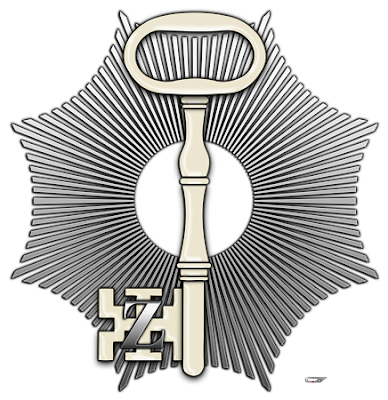 5th Degree: Perfect Master 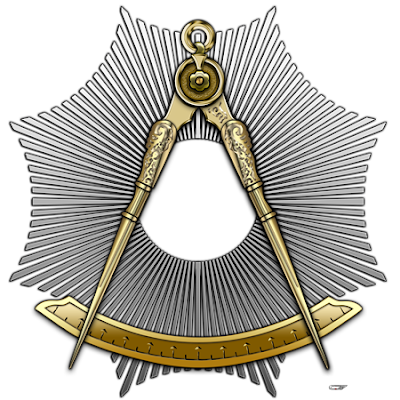 The apron is of white lambskin. The lining, border and flap are light green. Two crossed columns with three concentric circles and a golden cube superimposed form the center design of the apron. The outside circle is crimson, the center one blue and the inner one orange. There are two letters upon the top face of the cube; the one on the left black and the other white. The cube represents the finite universe and the three circles symbolize the wisdom, power and beneficence of God; the great trinity of His attributes. The letters are Phoenician and are the first two letters of the ancient name of God. The jewel is the compasses, opened to sixty degrees, the points on a graduated arc. Masonic compasses are opened to sixty degrees because this is the number of degrees in each of the three angles of an equilateral triangle, always a symbol of Deity. It is suspended from a broad grass-green watered ribbon worn from the right shoulder to the left hip. This jewel, absent the square, indicates that the candidate is moving away from the earthly and toward the heavenly: "[The Square] ... is an emblem of what concerns the earth and the body; [the Compasses] of what concerns the heavens and the soul" The color of the ribbon symbolizes the attainment of this transition by renewal of virtue. 6th Degree: Intimate Secretary 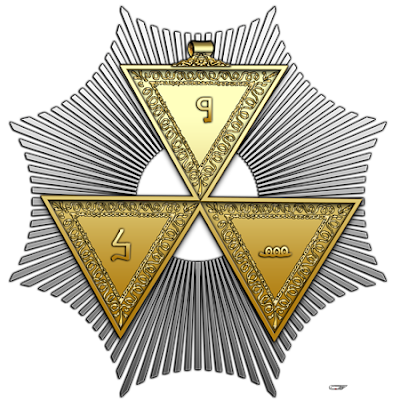 The apron is white and red, with Hebrew letters YOD HEH in the center, and a small triangle containing the Hebrew letters (clockwise from top) BETH, NUN, and SHIN. The jewel is a triple-delta superimposed upon an equilateral triangle of gold. Each delta has a center design composed of one of the astrological signs for the Sun, Moon and Mercury. As explained in the degree summary, the form of the jewel is utterly derived from Pike's favorite source of Masonic Symbolism, the Pythagorean Tetractys. 7th Degree: Provost and Judge 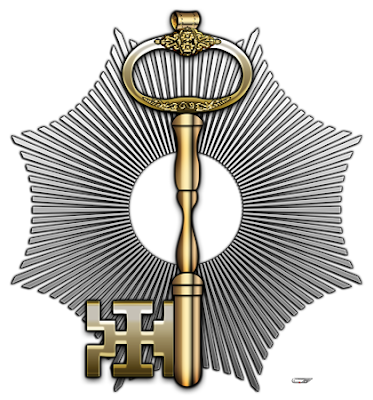 The apron is of white lambskin edged in red. In the center is a red-edged pocket with a red and white rosette just below the opening. This pocket holds the plans for the Temple. On the flap is embroidered a hand of justice holding a scale. The jewel is a gold key which unlocks the ebony box seen in the ceremony. The ebony box represents the human heart where the candidate is to lock up the secrets of the order and as Mackey says, "... in the human heart are deposited the secret designs and motives of our conduct by which we propose to erect the spiritual temple of our lives" This key is especially emblematic of that justice and uprightness that alone can unlock for us the mysteries contained in the higher degrees and enable us to advance toward perfection. 8th Degree: Intendant of the Building 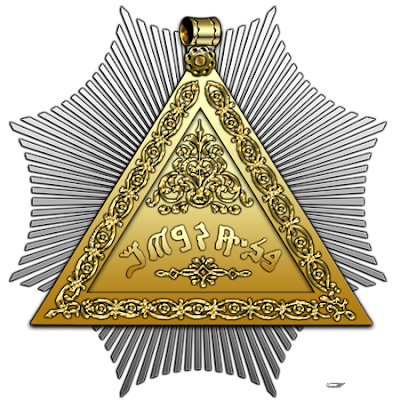 The apron is white, lined with red and bordered with green; in the center is an embroidered nine-pointed star and over that a balance. On the flap is a triangle, with Phoenician letters at each angle. The three colors white, red and green, the chief symbolic colors of Scottish Rite Masonry, teach is to imitate the purity of morals and zeal for the service of Masonry which have made our deceased Master immortal in the recollection of men. The jewel is a delta of gold. On one side is engraved or enameled a Phoenician word meaning 'nobles' or 'freeborn'; on the reverse the letters are Samaritan and stand for Achad, or 'our only God, chief and source of all'. Pike derives this interpretation from its root which means 'first'. The triangular shape is the most fundamental symbol of the Deity. 9th Degree: Elu of the Nine 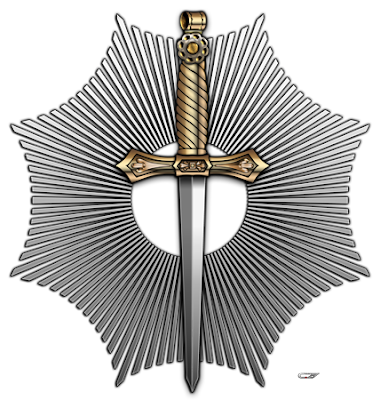 The apron is white lambskin spotted with red; it is lined and bordered in black. An arm holding a dagger is painted or embroidered on the flap. In the middle is an arm holding a bloody head by the hair. The apron is an emblem of Masonry and Truth sprinkled with the blood of those who have been persecuted for the sake of both. It is also representative of the darkness of ignorance, error and intolerance, with which the world is shrouded, and through which Masonry moves like a star, dispensing light and knowledge and toleration. The arm holding a dagger reminds us of the execution of the sentence registered in heaven against ignorance and error. The hand holding the bloody head represents the just punishment of those who degrade and brutalize the human soul, by hiding from it the light of knowledge. The jewel is a dagger, its hilt of gold and its blade of silver. These two metals in combination symbolize the brilliance of the combined light of the sun and the moon. We also see this meaning in the ancient Han characters of China where the character for 'sun' is merged with the character for 'moon' to form the character for 'brilliant'. This dagger is not an emblem of false bravery but of the weapons of legitimate warfare, which an Elu of Nine may lawfully use, and especially of the two-edged sword of truth with which every Mason should be armed. A reference to the dagger is also found in the lecture for the Knight of the Brazen Serpent Degree, "Even the dagger of the Elu of the Nine is that used by the Mysteries of Mithras [a Persian deity]; which, with its blade black and hilt white, was an emblem of the two principles of Light and Darkness". We shall see this symbol repeated in the poniard of the 30th Degree. 10th Degree: Elu of the Fifteen  The apron is white, lined, edged and fringed with black; the flap also is black. In the center are painted or embroidered three gates, and over each gate is a head impaled on a spike. The black represents the sorrow caused by the deed of those men whose heads now grace the arches. The heads themselves represent ignorance, tyranny, and fanaticism. It is against these vices that Masonry is particularly opposed. The jewel is a dagger, its hilt gold and its blade silver; it hangs from the end of the cordon. The cordon is a broad watered black ribbon, worn from right to left; on the front of which are embroidered three heads. The heads upon the cordon also represent ignorance, tyranny and fanaticism or intolerance, smitten by the sword of freedom. 11th Degree: Elu of the Twelve 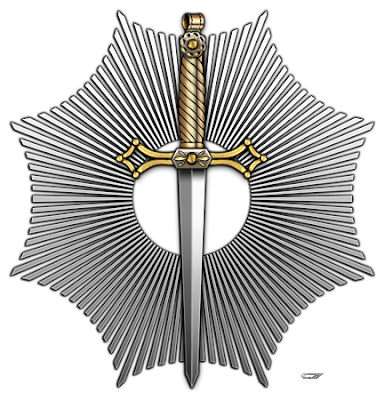 The apron is white, lined, edged and fringed with black and the flap is black. In the middle is an embroidered flaming heart. The flaming heart upon the apron and cordon are symbols of that zeal and devotedness that ought to animate all Masons and of those noble and heroic souls that have in all ages suffered and sacrificed themselves for their fellows or their country. The motto is a solemn pledge that one would rather die than betray the cause of the people or be overcome through his own fault. The jewel is a sword of gold, suspended from the cordon, and represents truth. The Elu of the Twelve have been given the title of Prince Ameth or Prince of Truth, for "Truth is sharper than any two-edged sword" 12th Degree: Master Architect 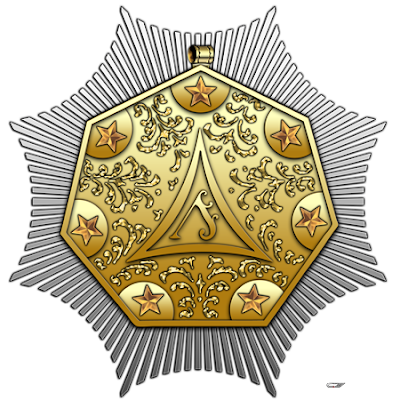 The apron is white, lined and bordered with blue, and fringed with gold. On the flap is embroidered a protractor; and in the middle of the body a plain scale, a sector and the compasses, arranged to form a triangle. The colors are to remind us of the degrees of the Symbolic Lodge, the foundation of Masonry. The jewel is a heptagonal medal of gold. On one side, in each angle is a five pointed star, enclosed by a semicircle. In the center, on the same side, is an equilateral triangle, formed by arcs of circles. On the reverse side are five columns, representing the different orders of architecture, arranged from left to right, with the initial of the proper order below each, in old English letters - [T]uscan, [D]oric, [I]onic, [C]orinthian, [C]omposite. Above these columns are a sector and a slide-rule; below them, the three kinds of compasses, the plain scale and the parallel ruler. Between the second and third and the third and fourth columns are Phoenician letters equivalent to the English or Roman letters 'R' and 'B'. These letters have two meanings, one exoteric and the other esoteric. The exoteric meaning all may know; it is simply the initials of Rab Benaim, the Semitic name for the degree. You should pay particular attention to the symbolic meanings of the jewel and its designs in the ritual. 13th Degree: Royal Arch of Solomon 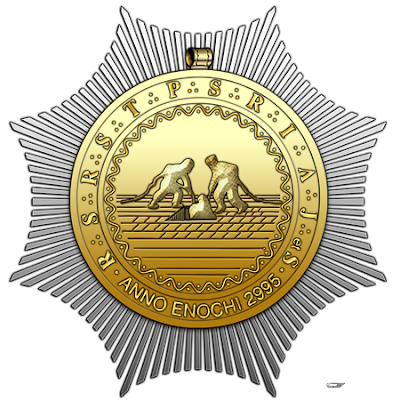 The apron is of crimson velvet. Upon it is embroidered a triangle emitting rays, and in the middle a letter, an archaic form of the Semitic Yod. The color denotes the zeal and devotedness of a Royal Arch Mason. The triangle is the emblem of Deity, or Infinite Wisdom, Infinite Power and Infinite Harmony; the letter represents the Tetragammaton, the Name of God made known to Moses. The jewel is a circular medal of gold, around which, on one side are the following letters, words and number: R, S, R, S, T, P, S, R, I, A, J, et S, ANNO ENOCHI 2995. On the same side is an engraving of the ground with a rectangular hole in it into which two men are lowering a third with a rope. On the reverse side is a triangle emitting rays and in the middle of it the same letter as is on the apron. This medal is to be worn upon the chest, suspended by a narrow, white watered ribbon. The letters stand for: Regnante Solomone, Rege Sapientissimo, Thesaurum Pretiosissimum Sub Ruinis Invenerunt Adonirum, Joabert, et Satolkin ... Anno Enochi 2995; or 'In the reign of Solomon, wisest of kings, Adonirum, Joabert and Satolkin found under the ruins the most precious treasure'. Let the emblem on the reverse side of the jewel always remind us that the good Mason reveres and adores the Grand Architect of the Universe, and endeavors, by pursuing the path of honor and duty, to perform the part assigned him in the world well and faithfully. 14th Degree: Perfect Elu  The apron is of white lambskin, lined with crimson and edged with blue. Around it, on the inside of the blue edging is a delicate embroidery in crimson representing a wreath of flowers. In the middle of the apron is painted or embroidered the jewel, and on the flap is a representation of a flat square stone to which is attached a ring, representing the entrance to the secret vault of the preceding degree. Of its three colors, white, like the snowy purity of the ermine, represents justice; blue, the color of the perfectly symmetrical and changeless arch of the sky, represents right; and crimson, the color of fire which tries and purifies all things, represents truth. The jewel is a pair of compasses, opened upon a quarter of a circle, and surmounted by a pointed crown. Within the compasses is a medal, representing on one side the sun, and on the other a five-pointed star, in the center of which is a delta, and on that the name of Deity in Phoenician characters. This jewel is gold and worn suspended from the collar. On the segment of the circle are enameled, at proper distances from each other, the numerals III ... V ... VII ... IX. The compasses remind us that science, united to honor and virtue, made the architect of the Temple the companion of kings; and that the men of intellect and learning, the great kings of thought, are in this age the rulers of the world. The sun as the source of light to our system was once worshiped as a god. The star as a type of the myriad suns that light other countless systems of worlds is an emblem of that Masonic Light in search of which every Mason travels - the correct knowledge of the Deity and of His laws that control the universe. |
 Re: LOS 33 GRADOS DEL RITO ESCOCES ANTIGUO Y ACEPTADO
Re: LOS 33 GRADOS DEL RITO ESCOCES ANTIGUO Y ACEPTADO
Council, Princes of Jerusalem
Degrees 15° through 16°
The Council of Princes of Jerusalem teach lessons using settings based on the ancient captivity of the Hebrews and the building of the second Temple.
15th Degree: Knight of the East
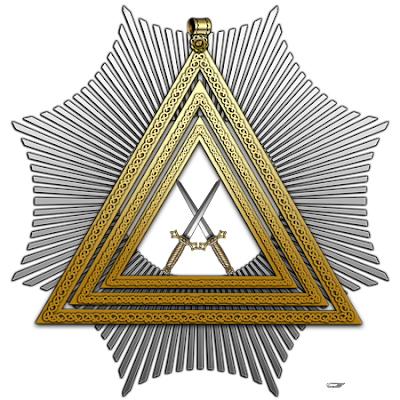 As many other degrees in Scottish Rite, 15th Degree is known by several names: Knight of the East, or Knight of the Sword, or Knight of the Eagle in Southern Jurisdiction, and Knight of the East, or
As many other degrees in Scottish Rite, 15th Degree is known by several names: Knight of the East, or Knight of the Sword, or Knight of the Eagle in Southern Jurisdiction, and Knight of the East, or
Knight of the Sword in Northern Jurisdiction and Canada. The lesson of the 15° is to rebuild the Masonic Temple of liberty, equality and fraternity in the souls of men. In this degree "we learn fidelity to obligations and perseverance of purpose under difficulties and discouragement." This degree teaches that it is not possible to keep people in slavery once they know the value of liberty and can decide for themselves how to define it. Likewise, it is not possible to defeat Masonry by attacking it; for we are building the Temple of liberty, equality, and fraternity in the souls of men and nations.
The apron is crimson velvet. On the flap is an embroidered gold bleeding head over crossed swords. In the center are three nested gold triangles formed from chains with triangular links. These represent the chains on the human intellect; tyranny, superstition and privilege. The velvet signifies that the honors of Masonry are more precious than the gift of kings.
The jewel is three nested triangles of gold. In the center are two crossed swords, points upward, the hilts resting on the base of the inner triangle. The nested triangles symbolize liberty, equality and fraternity; and also law, order and subordination. The crossed swords, truth and justice.
16th Degree: Prince of Jerusalem
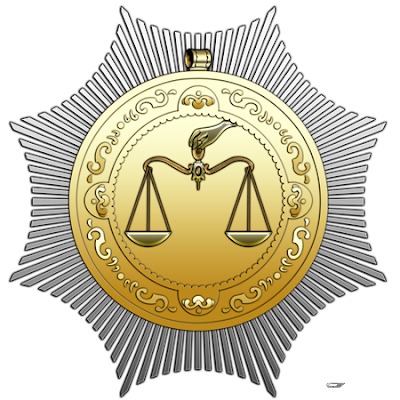 The lessons of the 16th Degree: Prince of Jerusalem are to aid those who labor to build the Symbolic Temple; to judge equitably and fairly; to keep faith in the justice and beneficence of God and to press forward with hope for the persecuted and oppressed. This degree teaches "heroism of patience, the nobility of self-sacrifice" and compassionate judgment, along with charity, fidelity and brotherhood. This degree emphasizes the fact that one must use every means to be beneficial for the society in which one lives. We not only set our own example for our society, but we enlist the aid of our Brothers. Together, Masons are custodians of freedom. Our charge is to leave a noble heritage to those who follow us in this world. We build temples of the Living God in our hearts by following the truths of justice, equity, morality, wisdom, labor, fidelity and Brotherhood - so that the collective liberties for mankind can be protected.
The lessons of the 16th Degree: Prince of Jerusalem are to aid those who labor to build the Symbolic Temple; to judge equitably and fairly; to keep faith in the justice and beneficence of God and to press forward with hope for the persecuted and oppressed. This degree teaches "heroism of patience, the nobility of self-sacrifice" and compassionate judgment, along with charity, fidelity and brotherhood. This degree emphasizes the fact that one must use every means to be beneficial for the society in which one lives. We not only set our own example for our society, but we enlist the aid of our Brothers. Together, Masons are custodians of freedom. Our charge is to leave a noble heritage to those who follow us in this world. We build temples of the Living God in our hearts by following the truths of justice, equity, morality, wisdom, labor, fidelity and Brotherhood - so that the collective liberties for mankind can be protected.
The apron is of crimson, lined and edged with the color saffron. On the flap is an equal balance, held by a hand of justice. In the middle of the apron is a representation of the Second Temple, on one side of which is a sword lying across a buckler, and on the other, a square and a triangle. On the left and right sides are the Phoenician letters equivalent to the Greek letters Alpha and Theta. The colors, crimson bordered with that of the dawn (saffron), are symbolic of faith in the justice and beneficence of God, and of the dawn of hope for the persecuted, proscribed and oppressed. The equal balance, held by the hand of justice, is a symbol of righteousness and impartiality in judgment and of that equilibrium which the Deity maintains throughout the universe. The square and triangle are the appropriate emblems of your Masonic character. Masons, in this and higher degrees, wear the apron in order that they may never forget that they attained their high rank and dignity by means of Masonic labor; and that, remembering their first estate, they may be courteous and kind, as well as just, to the brethren of the lower degrees.
The jewel is a medal of gold. On one side is engraved a hand, holding an equal balance, symbolizing the justice and mercy of God, held in equipoise by His single will and infinite wisdom. On the other is a double-edged, cross-hilted sword, with one star over the point and two on each side. The sword stands upright, hilt downward. On one side of the stars is the letter 'D', and on the other, the letter 'Z', the initials of Darius and Zerubbabel.
Chapter of the Rose Croix
Degrees 17° through 18°
The Chapter of Rose Croix attempts to provide the candidate with a deeper understanding of religion, philosophy, ethics and history though a variety of complex "historical degrees". The intellectual challenges presented in these degrees are numerous, and at times overwhelming and can take years to master. A thorough reading of the chapters related to them in Morals and Dogma and in Legenda and Readings is essential to achieve even a basic comprehension of their true meaning.
17th Degree: Knight of the East and West
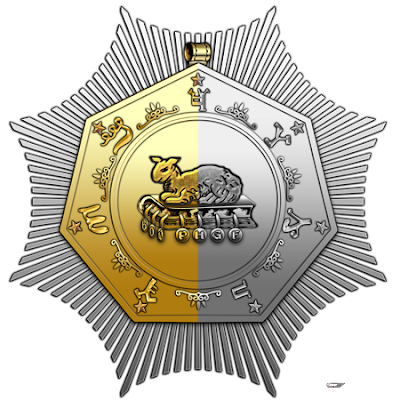 The lessons of the 17th Degree: Knight of the East and West are to work, reflect and pray; to hope, trust and believe; to teach the truths that are hidden in allegory and concealed by the symbols of Freemasonry. The lessons of this degree are that loyalty to God is man's primary allegiance, and the temporal governments not founded upon God and His righteousness will inevitably fall. In this degree, Masonry says only one thing – differences in religions will not matter, and these differences will not hinder people to live together in peace if all people gather sincerely around the belief and concept of the GAOTU. It is sufficient only to keep one's heart pure, to believe in God, and to respect the religious feelings and ideas of others. In this way, people who meet, respect and love one another will not find it difficult to understand that no one is lying, that truth prevails in people's words and deeds.
The lessons of the 17th Degree: Knight of the East and West are to work, reflect and pray; to hope, trust and believe; to teach the truths that are hidden in allegory and concealed by the symbols of Freemasonry. The lessons of this degree are that loyalty to God is man's primary allegiance, and the temporal governments not founded upon God and His righteousness will inevitably fall. In this degree, Masonry says only one thing – differences in religions will not matter, and these differences will not hinder people to live together in peace if all people gather sincerely around the belief and concept of the GAOTU. It is sufficient only to keep one's heart pure, to believe in God, and to respect the religious feelings and ideas of others. In this way, people who meet, respect and love one another will not find it difficult to understand that no one is lying, that truth prevails in people's words and deeds.
The apron is of yellow silk, lined and edged with crimson; the colors are emblematic of the dawn. Its triangular shape is symbolic of the Deity in His first three emanations. In the center is a gold Tetractys formed of 10 Hebrew Yods. They represent the ten Sephiroth (or manifestations of Deity) on the Tree of Life in the Kabalah.
The jewel is a heptagonal (seven-sided) medal, half gold and half silver or mother of pearl. These two colors are emblems of the sun and moon, themselves symbols of the Egyptian deities Osiris and Isis, who represent the generative and productive powers of nature, illustrated in Masonic Symbolism by the columns Jachin and Boaz as the active and passive forces manifested in nature (Morals and Dogma, p. 202). On one side are engraved, at the angles, the same letters as are on the capitals of the columns in the ceremony and possessing the same meaning, that of the last seven of the Sephiroth of the Kabalah. A star is over each. In the center, on the same side, is a lamb, lying on a book with seven seals, on which seals are, respectively, the same letters, though shown in this representation as the Roman equivalents. On the reverse side are two crossed swords, points upward; their hilts rest on an even balance. In the corners are the initials in Greek of the names of the Seven Churches
18th Degree: Knight Rose Croix
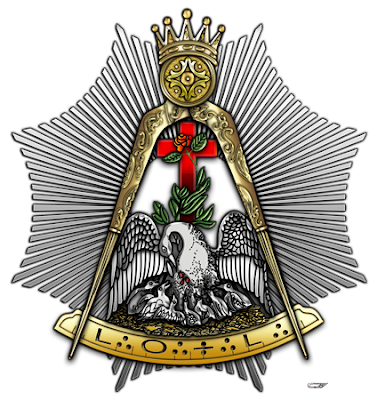 The lessons of the 18th Degree: Knight Rose Croix (Southern Jurisdiction and Canada), or Knight of the Rose Croix de Heredom (Northern Jurisdiction), are to practice virtue; to labor to eliminate vice; to purify humanity; to be tolerant of the faith and creed of others. This degree teaches that life and it's strengths come from God. The rose signifies the dawn and the cross is a sacred symbol of antiquity in many cultures. To be tolerant of others errors and faults. This degree teaches that, in reality, what causes us to be immortal is affection; is love. Only if one loves is he conscious that he lives, and that he therefore loves life. As Masons, we should practice virtue that it may produce fruit. We should have faith in God, mankind and ourselves. And we should be loving men. Masonry teaches that, so long as a man is loved, so long as he is remembered with love; he continues living in this way even in his grave.
The lessons of the 18th Degree: Knight Rose Croix (Southern Jurisdiction and Canada), or Knight of the Rose Croix de Heredom (Northern Jurisdiction), are to practice virtue; to labor to eliminate vice; to purify humanity; to be tolerant of the faith and creed of others. This degree teaches that life and it's strengths come from God. The rose signifies the dawn and the cross is a sacred symbol of antiquity in many cultures. To be tolerant of others errors and faults. This degree teaches that, in reality, what causes us to be immortal is affection; is love. Only if one loves is he conscious that he lives, and that he therefore loves life. As Masons, we should practice virtue that it may produce fruit. We should have faith in God, mankind and ourselves. And we should be loving men. Masonry teaches that, so long as a man is loved, so long as he is remembered with love; he continues living in this way even in his grave.
The apron is white satin bordered with crimson on one side and black on the other. On the white side is embroidered the pelican side of the jewel. On the black side is a large red passion cross.
The jewel is the compasses with points opened to sixty degrees and resting on the segment of a graduated circle. On the lower part, on one side, is an eagle, with his wings extended and head lowered. Among the Egyptians the eagle was the emblem of a wise man because his wings bore him above the clouds into the purer atmosphere and nearer to the source of light, and his eyes were not dazzled with that light. Since the eagle also represented the great Egyptian Sun god Amun-ra, it is a symbol of the infinite Supreme Reason or Intelligence. On the other side is a pelican, piercing its breast to feed its seven young in a nest under it. The pelican symbolizes every philanthropist and reformer who has offered up his life for the benefit of humanity, and so teaches us an exhaustless munificence toward all men, especially the needy and defenseless. It also represents the large and bountiful beneficence of nature, from whose bosom all created things draw their sustenance. Thus, the pelican and eagle together are symbols of perfect wisdom and perfect devotedness. There is a crimson cross showing on both sides; at the intersection of its arms on the pelican side, is a crimson rose in bloom. The cross, pointing to the four cardinal directions, and whose arms, infinitely extended would never meet, is an emblem of space or infinity. The cross has been a sacred symbol in many cultures from the earliest antiquity. The rose was anciently sacred to the sun and to Aurora, Greek Goddess of the dawn. As a symbol of the morning light, it represents resurrection and the renewal of life, and therefore immortality. Together the cross and rose symbolize immortality won by suffering and sorrow. On the summit of the compasses is an antique crown. On the segment of the circle, on the pelican side, is the word of this degree in special cipher. This jewel is of gold; the pelican and eagle upon it of silver.
Council of Kadosh
Degrees 19° through 30°
The third portion of the Scottish Rite System of degrees is called The Council of Kadosh. This series of degrees includes the 19th° through to the 30th° It is important to note that in Canada these degrees fall under Consistory, which in the USA consists of only the 31st and 32nd Degrees.
Degrees 19 - 29 make up what is known as the Degrees of AREOPAGUS which is derived from a court in ancient Athens of the same name. The 30th Degree or "Kadosh" means Holy or Consecrated. The degrees of the Council of Kadosh are chivalric and philosophical, but also contain mystical material. The word "Kadosh" is a Hebrew word meaning "Holy". The complexity of these degrees cannot be overstated.
19th Degree: Grand Pontiff
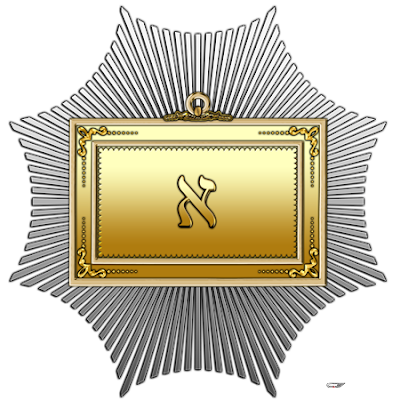 The lessons of the 19th Degree: Grand Pontiff are to be content to labor for the future; to serve the cause of truth with patience and industry; and to destroy error, falsehood and intolerance with truth, honesty, honour and charity. The lessons of this degree are learned from the past and how it affects the present and the way we live in the future. We always strive to endure, produce and improve the world as it surrounds us. The great lesson of this degree is that life, when properly, is but a bridge to eternal life. Once the secret of life after death is known, a man understands that there is no time but eternity. Therefore, calamities which happen are temporary and will not continue. We are not taken down by calamities, but remain strong to fight against oppression and ignorance; we have passed from the Alpha to the Omega, have learned all the letters of the alphabet and understand that Alpha comes after Omega, that life is renewed. There is no end to learning and science.
The lessons of the 19th Degree: Grand Pontiff are to be content to labor for the future; to serve the cause of truth with patience and industry; and to destroy error, falsehood and intolerance with truth, honesty, honour and charity. The lessons of this degree are learned from the past and how it affects the present and the way we live in the future. We always strive to endure, produce and improve the world as it surrounds us. The great lesson of this degree is that life, when properly, is but a bridge to eternal life. Once the secret of life after death is known, a man understands that there is no time but eternity. Therefore, calamities which happen are temporary and will not continue. We are not taken down by calamities, but remain strong to fight against oppression and ignorance; we have passed from the Alpha to the Omega, have learned all the letters of the alphabet and understand that Alpha comes after Omega, that life is renewed. There is no end to learning and science.
There is no apron. The jewel is an oblong square of solid gold, with the letter Aleph engraved on one side and Tau on the other. These letters are the first and last of the Hebrew alphabet as those upon the cordon are of the Greek. They should remind us of the love and veneration we owe to that Great Being, the source of all existence, the Alpha and Omega, the First and the Last. On His promises we rely with perfect confidence, in whose mercy and goodness we implicitly trust, and for the fulfillment of whose wise purposes we are content to wait.
20th Degree: Master of the Symbolic Lodge
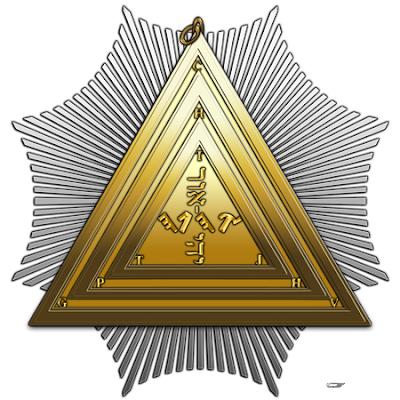 The lessons of the 20th Degree: Master of the Symbolic Lodge (Southern Jurisdiction) or Master ad Vitam (Northern Jurisdiction and Canada), are to dispense light and knowledge and to practice Masonic virtues. This degree shows us Liberty, Fraternity and Equality. These teach moral, religious and philosophical understanding. This degree helps one to comprehend Deity, forces of nature, good and evil. This degree teaches that a Mason who knows that he does not possess the qualities of leadership, and who has not duly prepared himself to be a leader, should not want to be one. Notwithstanding, every Mason should endeavor to educate himself, bearing in mind that one day he may be ask to lead. Because he is of his community, it expects him to dispense light and knowledge; to practice the virtues both in and out of lodge.
The lessons of the 20th Degree: Master of the Symbolic Lodge (Southern Jurisdiction) or Master ad Vitam (Northern Jurisdiction and Canada), are to dispense light and knowledge and to practice Masonic virtues. This degree shows us Liberty, Fraternity and Equality. These teach moral, religious and philosophical understanding. This degree helps one to comprehend Deity, forces of nature, good and evil. This degree teaches that a Mason who knows that he does not possess the qualities of leadership, and who has not duly prepared himself to be a leader, should not want to be one. Notwithstanding, every Mason should endeavor to educate himself, bearing in mind that one day he may be ask to lead. Because he is of his community, it expects him to dispense light and knowledge; to practice the virtues both in and out of lodge.
The apron is yellow, bordered and lined with sky-blue. In the center are three concentric equilateral triangles, with the initial letters of the nine Great Lights in the corners. The letters stand for the following: Charity, Generosity, Veneration, Heroism, Patriotism, Honor, Toleration, Truth and Justice. In the center of the inner Triangle is the Tetragrammaton in Phoenician characters. Across it, from below upwards, are the Hebrew letters Yod, He, Yod, written vertically bottom to top and sideways. The remaining letters are Aleph, Vau, Ras; together the letters form the Hebrew for "Let Light Be!" or, as in the King James Version of the Bible, "Let there be light".
The jewel is gold, like the triangles on the apron, with the same words and letters.
21st Degree: Noachite
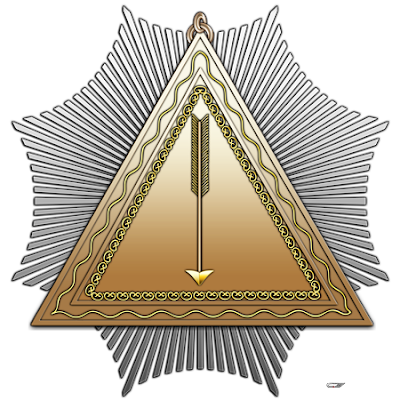 The lessons of the 21st Degree: Noachite or Prussian Knight (Southern Jurisdiction), or Patriarch Noachite (Northern Jurisdiction and Canada) are humility, modesty, trust in God and to be steadfast and courageous in the face of adversity. The lesson from this degree is to learn that arrogance; defamation and cowardice are unworthy attributes of a mason, and that humility, modesty and courtesy are the true virtues of men and Masons. The principle lesson of this degree is to not be conceited or belittle others. Nobody should rely on his wealth, nobility, heavenly or worldly titles. We should be humble and modest and sincerely seek God's mercy; for God protects those who are sincere and honest. A Mason should never lose hope and confidence in the fact that correctness and honesty will always be victorious.
The lessons of the 21st Degree: Noachite or Prussian Knight (Southern Jurisdiction), or Patriarch Noachite (Northern Jurisdiction and Canada) are humility, modesty, trust in God and to be steadfast and courageous in the face of adversity. The lesson from this degree is to learn that arrogance; defamation and cowardice are unworthy attributes of a mason, and that humility, modesty and courtesy are the true virtues of men and Masons. The principle lesson of this degree is to not be conceited or belittle others. Nobody should rely on his wealth, nobility, heavenly or worldly titles. We should be humble and modest and sincerely seek God's mercy; for God protects those who are sincere and honest. A Mason should never lose hope and confidence in the fact that correctness and honesty will always be victorious.
The apron and gloves of this degree are yellow. On the upper part of the apron is an arm, naked and upraised, holding a naked sword. Under it is a human figure, erect, with wings, the forefinger of his right hand on his lips; in his left hand he holds a key. He is the Egyptian figure of silence, called by the Greeks Harpocrates, though the wings are an addition. Plato said the wings symbolized 'intelligence'. To the alchemists they stood for the higher, active, male principle.
The jewel is a silver, full moon, suspended from the third buttonhole of the vest, or a golden triangle traversed by an arrow, point-upward, suspended from the collar. On the jewel is an arm upraised, holding a naked sword, and around it the motto, Fiat Justitia, Ruat Coelum, meaning 'Let there be Justice, though the Heavens fall'. These were the words of William Murray, First Earl of Mansfield (1704-1793), Lord Chief Justice of England, uttered in the case of Rex vs. Wilkes, June 8, 1768.
22nd Degree: Knight of the Royal Axe
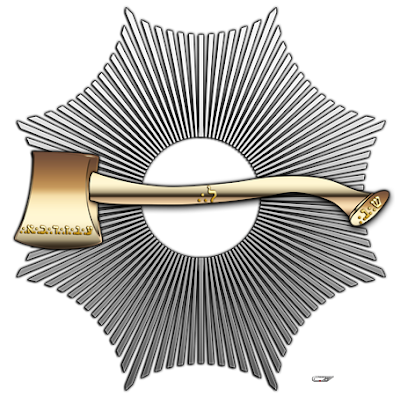 The lessons of the 22nd Degree: Knight of the Royal Axe or Prince of Libanus (Southern Jurisdiction), or Prince of Libanus (Northern Jurisdiction and Canada), are to respect labor for its own sake and to do work. This degree teaches, "if a job is worth doing its worth doing well". By doing good work we improve character and become better citizens. Work is the mission of man. We should respect our labor for its own sake, and do our work. Manual and mental work complete one another; thus, one who works in either manual or mental labor should not try to exploit, or oppress the other. A Mason must be a person who makes no distinction in the nature and kind of work in which his brother is engaged.
The lessons of the 22nd Degree: Knight of the Royal Axe or Prince of Libanus (Southern Jurisdiction), or Prince of Libanus (Northern Jurisdiction and Canada), are to respect labor for its own sake and to do work. This degree teaches, "if a job is worth doing its worth doing well". By doing good work we improve character and become better citizens. Work is the mission of man. We should respect our labor for its own sake, and do our work. Manual and mental work complete one another; thus, one who works in either manual or mental labor should not try to exploit, or oppress the other. A Mason must be a person who makes no distinction in the nature and kind of work in which his brother is engaged.
The apron is white, lined and bordered with purple. In the middle is embroidered a round table, on which are mathematical instruments and unrolled plans. On the flap is a serpent with three heads, denoting idleness, the body from which issues the three vices symbolized by the heads: drunkenness, impurity and gaming. By these vices many youths have been lost and many great nations have sunk into ignoble imbecility and shameful bondage.
The jewel, suspended from the collar, is a gold axe and handle, the symbol of the great agent of civilization and improvement. Troops armed with this weapon have conquered barbarism. Under its blow the primeval forests disappear; the early farmer displaces the wild hunter; to the rude barbarism of the early ages succeed settled society, laws and all the arts that refine and elevate mankind. The axe is nobler than the sword. Masonry hews at those mighty trees, intolerance, bigotry, superstition, uncharitableness and idleness, thereby letting in the light of truth and reason upon the human mind, which these vices have darkened for centuries. The letters on the top are the initials of Noah and Solomon; those on the handle, of Libanus and Tsidunian; those on one side of the blade, of Adonirum, Kuros, Darius, Zerubbabel, Nehemiah and Azra; and those on the other side, of Shem, Kham, Yapheth, Moses, Aholiab and Betselal. These names represent the various places and persons significant in the use of the cedars of Lebanon for 'Holy Enterprises'; examples include Noah's Ark, the Ark of the Covenant, Solomon's Temple, and the rebuilding of Jerusalem and the Temple by Zerubbabel.
23rd Degree: Chief of the Tabernacle
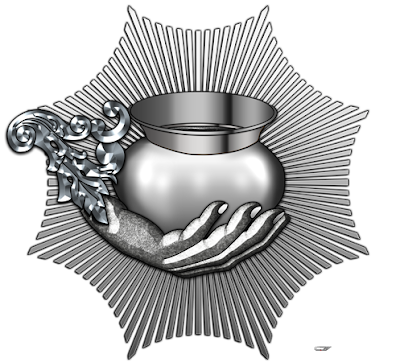 The lessons of the 23rd Degree: Chief of the Tabernacle are to be devoted to the service of God; to constantly endeavor to promote the welfare of man; to act with proper subordination to your superiors. This degree teaches that the man who forgets his duty to God, family, country, and himself will be in danger of morally and spiritually destruction by thoughts unworthy ambition. n this degree, we are reminded that we owe our knowledge to our faith in a revealed God. Therefore, it is our duty to disseminate this knowledge to all mankind. A Mason who believes in God has a duty to acquire knowledge and disseminate this knowledge to other people so that others are also enlightened. A Mason who is generous with his knowledge knows that he will receive the blessing of God, not by sacrificing living beings, but by destroying superstitions and bringing happiness and prosperity to other people.
The lessons of the 23rd Degree: Chief of the Tabernacle are to be devoted to the service of God; to constantly endeavor to promote the welfare of man; to act with proper subordination to your superiors. This degree teaches that the man who forgets his duty to God, family, country, and himself will be in danger of morally and spiritually destruction by thoughts unworthy ambition. n this degree, we are reminded that we owe our knowledge to our faith in a revealed God. Therefore, it is our duty to disseminate this knowledge to all mankind. A Mason who believes in God has a duty to acquire knowledge and disseminate this knowledge to other people so that others are also enlightened. A Mason who is generous with his knowledge knows that he will receive the blessing of God, not by sacrificing living beings, but by destroying superstitions and bringing happiness and prosperity to other people.
The apron is white, lined with scarlet and bordered with red, blue and purple ribbons. In the middle is painted or embroidered the golden candelabrum with seven lights. Josephus, the great Jewish historian, is the source of the design of the apron. He defines the symbolism of the colors as follows: white, the earth, from which the flax used in fine linen is grown; red, fire, from its color; blue, the sky, for the same reason; and, purple, the sea, for it derives from a sea mollusk. But to us there are deeper meanings: white, the infinite beneficence of God; blue, His profound and perfect wisdom; red, his glory; and, purple, His power. The candelabrum symbolizes to us, as to the ancients, the seven planets: the sun, the moon, Mercury, Venus, Mars, Jupiter and Saturn. It also represents the seven archangels and seven of the ten manifestations of Deity; specifically, the seven Sephiroth which follow Will, Wisdom and Understanding: Justice, Mercy, Beauty, Glory, Victory, Dominion and Kingdom.
The jewel is a small silver censer, or ornamental cup, with a long handle; the end serves as a stand for the cup and is shaped like an open hand. It should remind us to offer up unceasingly to God the incense of good deeds and charitable actions dictated by a pure and upright heart.
24th Degree: Prince of the Tabernacle
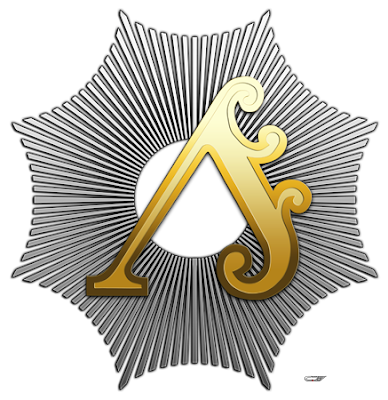 The lessons of the 24th Degree: Prince of the Tabernacle (Southern Jurisdiction and Canada) or Brother of the Forest (Northern Jurisdiction) are to labor incessantly for the glory of God, the honor of your country and the happiness of your brethren. In this degree a Mason must show evidence of compassion, piety and justice. After initiation he may "manifest faithfully the social virtues in order to receive the rewards", to serve humanity through our brotherhood. This also is a continuation of the last degree and examines the nature of knowledge. We must be vigilant not to accept corrupted and erroneous echoes of real knowledge. We have to distinguish for ourselves what is truth; for many do not realize that they are in error when they think they have found the truth. As Masons, we must fight continuously against superstitions, wrong knowledge, false prophets, tyrants, and despots. Our task is to free knowledge from the monopoly of classes, casts, leaders, or priests; and to disseminate it to everyone.
The lessons of the 24th Degree: Prince of the Tabernacle (Southern Jurisdiction and Canada) or Brother of the Forest (Northern Jurisdiction) are to labor incessantly for the glory of God, the honor of your country and the happiness of your brethren. In this degree a Mason must show evidence of compassion, piety and justice. After initiation he may "manifest faithfully the social virtues in order to receive the rewards", to serve humanity through our brotherhood. This also is a continuation of the last degree and examines the nature of knowledge. We must be vigilant not to accept corrupted and erroneous echoes of real knowledge. We have to distinguish for ourselves what is truth; for many do not realize that they are in error when they think they have found the truth. As Masons, we must fight continuously against superstitions, wrong knowledge, false prophets, tyrants, and despots. Our task is to free knowledge from the monopoly of classes, casts, leaders, or priests; and to disseminate it to everyone.
The apron is of white lambskin, lined with scarlet and bordered with light-green. In the middle is painted a representation of an Arabic tent, in gold. On the light blue flap is a representation of a myrtle tree of violet color, also an emblem of immortality.
The jewel is the Phoenician letter 'A' (Aleph), suspended from a short collar of narrow, watered violet-colored ribbon. It is another manifestation of the Pentagram, or Five-Pointed Star, because the star, viewed from any angle figures the letter 'A'. Since 'A' is the initial of one of the principle names of Deity, Adonai, or LORD, this star is a sign of intellectual omnipotence and autocracy.
25th Degree: Knight of the Brazen Serpent
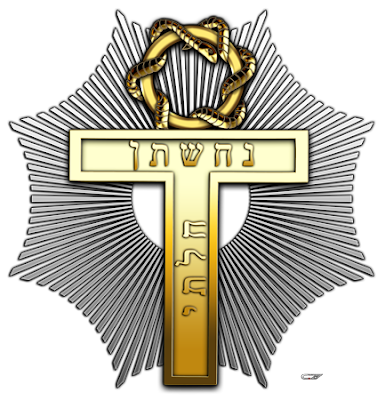 The lesson of the 25th Degree: Knight of the Brazen Serpent (Southern Jurisdiction and Canada), or Master of Achievement (Northern Jurisdiction) is to fulfill your destiny and to re-create yourself by reformation, repentance and enlarging your knowledge. This degree tackles the concept of pure, celestial, eternal soul of man. He looks within his faith, life, and God and to get a clear look at his inner self. This degree teaches the virtue of hospitality. One who shows hospitality to guests is obliged not to differentiate race, nationality or religion from whoever knocks at his door. The nature of Masonry is to heal those who are in distress from moral collapses, psychological crises, diseases by superstitions and ignorance. To save our fellows from these, to break the chains which represent moral slavery, to set men free, to be faithful and kind in every respect is the compulsory thing to do. We fulfill our destiny by re-creating ourselves, by enlarging our knowledge.
The lesson of the 25th Degree: Knight of the Brazen Serpent (Southern Jurisdiction and Canada), or Master of Achievement (Northern Jurisdiction) is to fulfill your destiny and to re-create yourself by reformation, repentance and enlarging your knowledge. This degree tackles the concept of pure, celestial, eternal soul of man. He looks within his faith, life, and God and to get a clear look at his inner self. This degree teaches the virtue of hospitality. One who shows hospitality to guests is obliged not to differentiate race, nationality or religion from whoever knocks at his door. The nature of Masonry is to heal those who are in distress from moral collapses, psychological crises, diseases by superstitions and ignorance. To save our fellows from these, to break the chains which represent moral slavery, to set men free, to be faithful and kind in every respect is the compulsory thing to do. We fulfill our destiny by re-creating ourselves, by enlarging our knowledge.
The apron is white, lined and edged with black; the white side spotted with golden stars, and the black side with silver ones. Those on the white side represent, by their positions and distances, the Pleiades, the Hyades, Orion and Capella. Those on the black side represent the stars of Perseus, Scorpio, and Ursa Major. In the middle of the white side is a triangle in a glory, in the center of which is the name of Deity in Phoenician characters. On the flap is a serpent in a circle, with his tail in his mouth; and in the circle so formed a scarab, or beetle. Over this is a star of gold, with the letter 'R' (for Regulus) over it; on the right side of the apron another, with the letter 'A' over it; and at the bottom of the apron another, with the letter 'F' over it.
The jewel is a Tau cross, of gold, surmounted by a circle - the Crux Ansata of Egypt - round which a serpent is entwined. On the upright part of the cross is engraved the Hebrew word meaning 'he has suffered' or 'been wounded', and on the arms the Hebrew word given in the Bible for the brazen serpent, 'Nakhustan'.
26th Degree: Prince of Mercy
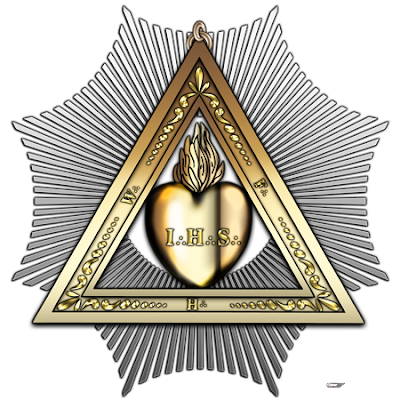 The lessons of the 26th Degree: Prince of Mercy or Scottish Trinitarian (Southern Jurisdiction and Canada) or Friend and Brother Eternal (Northern Jurisdiction) are to practice forgiveness and mercy; tolerance; to be devoted to the teaching of the principles of Masonry. In this degree we search for "the rewards of the trinity of Gods attributes - wisdom or intelligence, force or strength, harmony or beauty."
The lessons of the 26th Degree: Prince of Mercy or Scottish Trinitarian (Southern Jurisdiction and Canada) or Friend and Brother Eternal (Northern Jurisdiction) are to practice forgiveness and mercy; tolerance; to be devoted to the teaching of the principles of Masonry. In this degree we search for "the rewards of the trinity of Gods attributes - wisdom or intelligence, force or strength, harmony or beauty."
The apron is scarlet, with a wide border of white. In the center is an equilateral triangle formed of green bars. In the center of this is the jewel, embroidered in gold. The flap is sky-blue. The colors green, red and white symbolize the Masonic Trinity. Green is an emblem of the infinite wisdom; red of the supreme energy, force or power; and white, produced by the mingling of all colors, of the divine harmony.
The jewel is an equilateral triangle, of gold bars, with a flaming heart of gold in the center. On the heart are the letters 'I', 'H', 'S'; and on the respective sides of the triangle 'W' on the right, 'F' on the left, and 'H' at the bottom. This jewel is suspended from a small collar of watered purple ribbon and hangs on the breast. The last three letters stand for wisdom, force and harmony; the first three are traditional Christian initials for Iesus Hominum Salvator (the letters 'J' and 'I' are interchangeable in Latin) but which may also be read as Sapienta, Imperium, Harmonia. Thus, their Masonic meaning is the same meaning as the three upon the bars.
27th Degree: Knight of the Sun
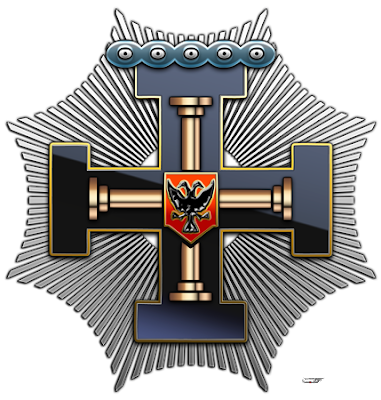 The lessons of the 27th Degree: Knight of the Sun or Prince Adept (Southern Jurisdiction), Knight of Jerusalem (Northern Jurisdiction) and Commander of the Temple (Canada) are to be a lover of wisdom and to be faithful to your promises made within Masonry. This lesson of this degree teaches us to scorn selfishness, and to uphold the knightly virtues of charity, truth and honor. We should always strive to assist the poor, helpless and infirm. This degree teaches the virtues of knighthood and asks its adherents to practice these virtues in life. Virtue requires duty; and both remain the same, regardless of the times. The Knight Commander of the Temple learns that he is the manager of the time, that he himself will decide when he will perform his duty; he does not wait for orders or authorization. He is his own man, and his task is to abolish distress at just the right time.
The lessons of the 27th Degree: Knight of the Sun or Prince Adept (Southern Jurisdiction), Knight of Jerusalem (Northern Jurisdiction) and Commander of the Temple (Canada) are to be a lover of wisdom and to be faithful to your promises made within Masonry. This lesson of this degree teaches us to scorn selfishness, and to uphold the knightly virtues of charity, truth and honor. We should always strive to assist the poor, helpless and infirm. This degree teaches the virtues of knighthood and asks its adherents to practice these virtues in life. Virtue requires duty; and both remain the same, regardless of the times. The Knight Commander of the Temple learns that he is the manager of the time, that he himself will decide when he will perform his duty; he does not wait for orders or authorization. He is his own man, and his task is to abolish distress at just the right time.
The apron is of scarlet lambskin, lined in black, with a Teutonic Cross (cross potent sable, charged with a smaller cross double potent or, surcharged with the escutcheon of the Empire - the two-headed black eagle) and a black key surrounded by a laurel wreath.
The jewel is the Teutonic Cross shown on the apron.
28th Degree: Knight Commander of the Temple
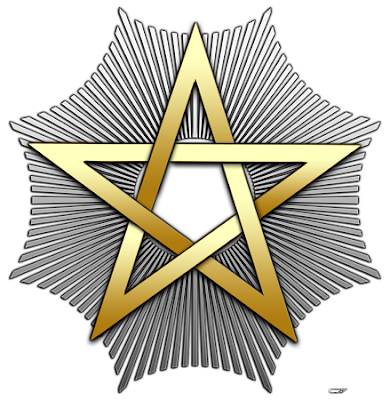 The lessons of the 28th Degree: Knight Commander of the Temple (Southern Jurisdiction), Knight of the Sun, or Prince Adept (Northern Jurisdiction) or Knight of the Sun (Canada) are to be devoted to truth, honour, loyalty, justice and humanity. This degree teaches that our love for God manifests itself in our love for Truth, Justice and Nobility of Soul. This degree points out seven truths: There exists an indefinable and incomprehensible principle that governs the universe. Human life is but a speck of eternity. Universal equilibrium is a result of a balance between similarities and contrasts. The absolute is the soul in its proper essence. The visible is the invisible. Evil, disaster, and misery are indispensable for universal equilibrium. Similarities are the only keys for comprehending nature. The majority of men fail to realize their errors. Masons are required to take up the arduous struggle against error. The moral code of Masonry is more extensive than that of philosophy.
The lessons of the 28th Degree: Knight Commander of the Temple (Southern Jurisdiction), Knight of the Sun, or Prince Adept (Northern Jurisdiction) or Knight of the Sun (Canada) are to be devoted to truth, honour, loyalty, justice and humanity. This degree teaches that our love for God manifests itself in our love for Truth, Justice and Nobility of Soul. This degree points out seven truths: There exists an indefinable and incomprehensible principle that governs the universe. Human life is but a speck of eternity. Universal equilibrium is a result of a balance between similarities and contrasts. The absolute is the soul in its proper essence. The visible is the invisible. Evil, disaster, and misery are indispensable for universal equilibrium. Similarities are the only keys for comprehending nature. The majority of men fail to realize their errors. Masons are required to take up the arduous struggle against error. The moral code of Masonry is more extensive than that of philosophy.
The apron is of pure white lambskin and has no edging or pattern except the interlaced pentagram, which is traced in the middle in vermillion.
There are three jewels. The presiding officer wears a jewel that is a representation of the sun in gold, suspended by a chain of gold and worn around the neck. The reverse is a hemisphere of gold showing the northern half of the ecliptic and a zodiac, with the signs from Taurus to Libra inclusive. The other officers wear a jewel composed of a simple seven-pointed star of gold. The remaining members of the council wear a jewel that is a gold five-pointed star. Only the jewel of the degree is shown in the illustration.
29th Degree: Scottish Knight of Saint Andrew
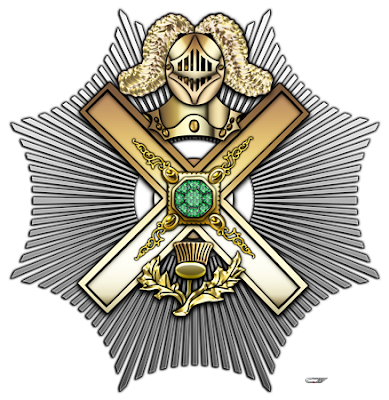 The lessons of the 29th Degree: Scottish Knight of Saint Andrew (Southern Jurisdiction) or Knight of Saint Andrew (Northern Jurisdiction and Canada) are to reverence and obey God; to serve the truth; to protect virtue and innocence; to defend the people against tyranny. The virtues of this degree are "Love of God, loyalty to superiors, faithful adherence to promise and active resistance to unfair judgment." In this degree, the Mason learns that there is no contradiction between religion and science; that religion can be better understood through science and science can be better understood by religion. He who denies science is as fanatical as he who denies religion. Our lifetime is limited in time; thus we must see God within this limited period of our time. Yet, God transcends all time; he is energy over and beyond time. There is no other energy that creates that energy. There is no end to that energy. Freemasonry is thus the continual effort to exalt the divine in man over the human so that we may come to better understand the nature of God in our time.
The lessons of the 29th Degree: Scottish Knight of Saint Andrew (Southern Jurisdiction) or Knight of Saint Andrew (Northern Jurisdiction and Canada) are to reverence and obey God; to serve the truth; to protect virtue and innocence; to defend the people against tyranny. The virtues of this degree are "Love of God, loyalty to superiors, faithful adherence to promise and active resistance to unfair judgment." In this degree, the Mason learns that there is no contradiction between religion and science; that religion can be better understood through science and science can be better understood by religion. He who denies science is as fanatical as he who denies religion. Our lifetime is limited in time; thus we must see God within this limited period of our time. Yet, God transcends all time; he is energy over and beyond time. There is no other energy that creates that energy. There is no end to that energy. Freemasonry is thus the continual effort to exalt the divine in man over the human so that we may come to better understand the nature of God in our time.
There is no apron. The jewel is a St. Andrew's Cross, of gold, with a large emerald in the center, surmounted by the helmet of a knight, and with a thistle of gold between the arms at the bottom. It is worn suspended from the collar. The emerald signifies the manliness and uprightness of chivalry, its color that of the renewal of virtue, always bright and sparkling. The thistle is the national emblem of Scotland and recalls a tradition that the Danes invaded Scotland and stealthily surrounded Staines Castle. They took off their shoes to wade the moat, only to find it dry and filled with thistles. The resultant yells and curses roused the garrison, and the Danes were soundly defeated.
30th Degree: Knight Kadosh
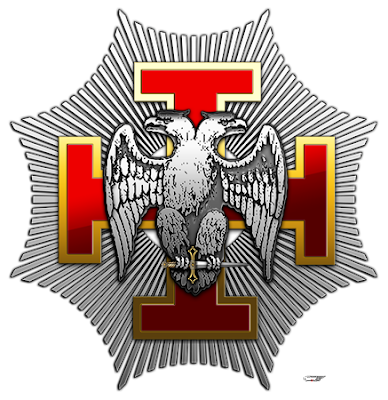 The lesson of the 30th Degree: Knight Kadosh or Knight of the White and Black Eagle (Southern Jurisdiction and Canada) or Grand Inspector (Northern Jurisdiction) is to labor unceasingly for the good of mankind. The lesson of this degree is to be true to ourselves, to stand for what is right and just in our lives today. To believe in God, country and ourselves. This is the last of the philosophical degrees. To spread the sciences, to apply the virtues, to learn the sublime doctrines which enable humanity to live as one great family - this is the school of which Masonry is engaged. It is not within the realm of Masonry to punish oppressors and tyrants who enact barriers to brotherly love and affection. They are always punished in the course of history. It is our goal to defeat the passions and fanaticism which led to oppression by spreading love and toleration. The Knight Kadosh is aware of his obligations. He is just, equitable, and respectful of all ideas. He battles for freedom of conscience. He opposes those who would attack these liberties, but material revenge is not in his thoughts and philosophy. He is a lover of great example.
The lesson of the 30th Degree: Knight Kadosh or Knight of the White and Black Eagle (Southern Jurisdiction and Canada) or Grand Inspector (Northern Jurisdiction) is to labor unceasingly for the good of mankind. The lesson of this degree is to be true to ourselves, to stand for what is right and just in our lives today. To believe in God, country and ourselves. This is the last of the philosophical degrees. To spread the sciences, to apply the virtues, to learn the sublime doctrines which enable humanity to live as one great family - this is the school of which Masonry is engaged. It is not within the realm of Masonry to punish oppressors and tyrants who enact barriers to brotherly love and affection. They are always punished in the course of history. It is our goal to defeat the passions and fanaticism which led to oppression by spreading love and toleration. The Knight Kadosh is aware of his obligations. He is just, equitable, and respectful of all ideas. He battles for freedom of conscience. He opposes those who would attack these liberties, but material revenge is not in his thoughts and philosophy. He is a lover of great example.
There is no apron. The jewel is a double headed eagle, with wings spread. The eagle rests upon a Teutonic Cross. The eagle is of silver, and the cross of gold, enameled with red.
The Consistory
Degrees 31° through 32°
The Consistory Degrees are very different from all the preceding degrees. They attempt to illustrate the creation of the ideal balance between the spiritual and the temporal.
31st Degree: Inspector Inquisitor
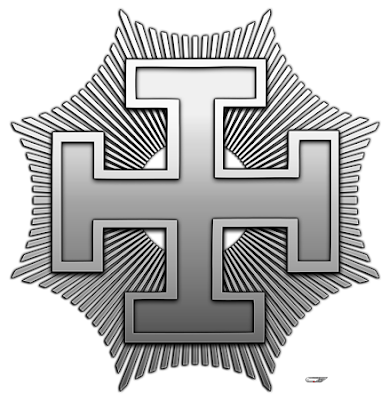 The lesson of the 31st Degree: Inspector Inquisitor (Southern Jurisdiction), Knight Aspirant (Northern Jurisdiction), or Inspector Inquisitor Commander (Canada) is to judge yourself in the same light as you judge others, considering both actions and motives. This degree teaches prayerful self-examination. The mistakes today should not be committed tomorrow. Simply, the daily look at ones self to learn to live with the future. The central teaching of this degree is justice. To be free, a Mason must begin by passing judgment on himself. He presents himself for examination. By acting honestly in first giving judgment on himself within the principles of justice and equity, it should not be doubted when he shall do the same to his brothers. The brother who finds mercy in himself, who has not been too lenient towards himself, or punish himself too severely, can also judge his brothers. In so doing, he can be certain that he has not acted contrary to his former obligations. He has freed himself.
The lesson of the 31st Degree: Inspector Inquisitor (Southern Jurisdiction), Knight Aspirant (Northern Jurisdiction), or Inspector Inquisitor Commander (Canada) is to judge yourself in the same light as you judge others, considering both actions and motives. This degree teaches prayerful self-examination. The mistakes today should not be committed tomorrow. Simply, the daily look at ones self to learn to live with the future. The central teaching of this degree is justice. To be free, a Mason must begin by passing judgment on himself. He presents himself for examination. By acting honestly in first giving judgment on himself within the principles of justice and equity, it should not be doubted when he shall do the same to his brothers. The brother who finds mercy in himself, who has not been too lenient towards himself, or punish himself too severely, can also judge his brothers. In so doing, he can be certain that he has not acted contrary to his former obligations. He has freed himself.
Though no apron is worn in the Tribunal, there was an apron that was to be worn when the Inspector Inquisitor visited an inferior body. That custom has been dispensed with but the apron is still a part of the history and symbolism of the degree; so it is displayed here. It is of pure white lambskin with a Teutonic Cross embroidered in black and silver upon the flap.
The jewel of the degree is a Teutonic Cross of silver worn with a white watered ribbon around the neck.
32nd Degree: Master of the Royal Secret
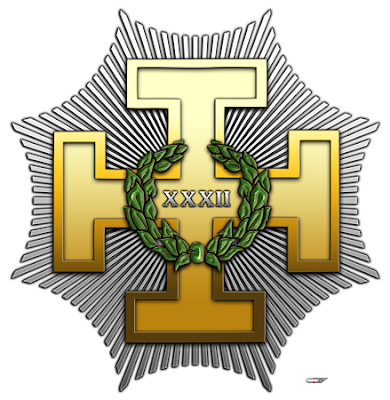 The lessons of the 32nd Degree: Master of the Royal Secret (Southern Jurisdiction) or Sublime Prince of the Royal Secret (Northern Jurisdiction and Canada) are: a Soldier of the Light seeks truth and knowledge; a Soldier of Freedom demands for the people free vote and voice and attains freedom of voice, vote and opinion for himself; a Soldier of the True Religion combats spiritual tyranny with reason and truth; a Soldier of the People encourages men to be self-reliant and independent; a Soldier of Scottish Rite Masonry is zealous and ardent in the performance of his duties to God, his country, his family, his brethren and himself. This degree teaches many lessons, but the mystery concealed is that man is a creature of free will and capable of recreating himself. If he accomplishes this goal, he will attain a genuine power that can shake the limits of science, surpass the problems of this earth, decipher the secrets of space, surpass the limits of ceremony and catechism, and attain genuine enlightenment; a gnosis which is the foundation of all religions. He will also surpass the narrow views of interest in the area of morals, and will comprehend a genuine virtue that transcends his own interest. Thus, it will become his nature to help his fellow men, and, in so doing, he will discover the divine light within which brings true freedom of thought, freedom of conscience, and freedom of culture.
The lessons of the 32nd Degree: Master of the Royal Secret (Southern Jurisdiction) or Sublime Prince of the Royal Secret (Northern Jurisdiction and Canada) are: a Soldier of the Light seeks truth and knowledge; a Soldier of Freedom demands for the people free vote and voice and attains freedom of voice, vote and opinion for himself; a Soldier of the True Religion combats spiritual tyranny with reason and truth; a Soldier of the People encourages men to be self-reliant and independent; a Soldier of Scottish Rite Masonry is zealous and ardent in the performance of his duties to God, his country, his family, his brethren and himself. This degree teaches many lessons, but the mystery concealed is that man is a creature of free will and capable of recreating himself. If he accomplishes this goal, he will attain a genuine power that can shake the limits of science, surpass the problems of this earth, decipher the secrets of space, surpass the limits of ceremony and catechism, and attain genuine enlightenment; a gnosis which is the foundation of all religions. He will also surpass the narrow views of interest in the area of morals, and will comprehend a genuine virtue that transcends his own interest. Thus, it will become his nature to help his fellow men, and, in so doing, he will discover the divine light within which brings true freedom of thought, freedom of conscience, and freedom of culture.
The apron is white, lined in black, with a double-headed eagle and a plan of the Camp of the Princes.
The jewel of the order is a Teutonic Cross of gold with arms frosted. In the center are the letters 'XXXII°', surrounded by a green wreath.
Supreme Council
33°
The Scottish Rite confers a number of honors upon members who have contributed extraordinary service to the Rite, to Masonry in general, and to the world at large.
33rd Degree: Sovereign Grand Inspector General
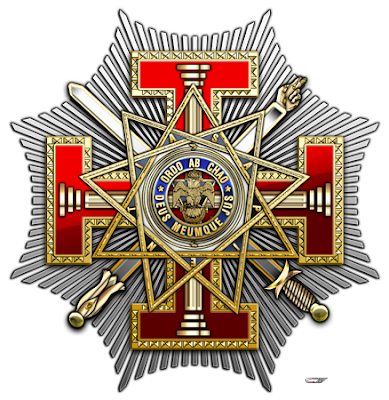 The Thirty-third Degree is conferred by the Supreme Council upon members of the Rite in recognition of outstanding work in the Rite or in public life. At its biennial session, the Supreme Council elects members of the Rite to receive the degree. Members unanimously so elected become honorary members of the Supreme Council. The Thirty-third Degree may not be requested, and if requested must be refused. The degree is granted solely out of recognition for outstanding services. These 33° Masons are Inspectors General Honorary and honorary members of the Supreme Council. The active members of the Supreme Council are chosen from among them. The cap for an Inspector General Honorary is white with a white band edged in gold, featuring the symbol for this honorary degree, a red slanting Patriarchal Cross.
The Thirty-third Degree is conferred by the Supreme Council upon members of the Rite in recognition of outstanding work in the Rite or in public life. At its biennial session, the Supreme Council elects members of the Rite to receive the degree. Members unanimously so elected become honorary members of the Supreme Council. The Thirty-third Degree may not be requested, and if requested must be refused. The degree is granted solely out of recognition for outstanding services. These 33° Masons are Inspectors General Honorary and honorary members of the Supreme Council. The active members of the Supreme Council are chosen from among them. The cap for an Inspector General Honorary is white with a white band edged in gold, featuring the symbol for this honorary degree, a red slanting Patriarchal Cross.
The emblem is a black double-headed eagle, with golden beaks and talons, holding in the latter a sword of gold, and crowned with the golden crown of Prussia. The red Teutonic cross is affixed to the left side of the breast.
The decoration rests upon a Teutonic cross. It is a nine-pointed star, namely, one formed by three triangles of gold one upon the other, and interlaced from the lower part of the left side to the upper part of the right a sword extends, and in the opposite direction is a hand of, as it is called, Justice. In the center is the shield of the Order, azure (blue), charged with an eagle like that on the banner, having on the dexter (right) side a Balance or (gold), and on the sinister (left) side a Compass of the second, united with a Square of the second. Around the whole shield runs a band of the first, with the Latin inscription, of the second, Ordo ab Chao, meaning Order out of Disorder, which band is enclosed by two circles, formed by two Serpents of the second, each biting its own tail. Of the smaller triangles that are formed by the intersection of the greater ones, those nine that are nearest the band are of crimson color, and each of them has one of the letters that compose the word S.A.P.I.E.N.T.I.A., or Wisdom.
Degrees 15° through 16°
The Council of Princes of Jerusalem teach lessons using settings based on the ancient captivity of the Hebrews and the building of the second Temple.
15th Degree: Knight of the East

Knight of the Sword in Northern Jurisdiction and Canada. The lesson of the 15° is to rebuild the Masonic Temple of liberty, equality and fraternity in the souls of men. In this degree "we learn fidelity to obligations and perseverance of purpose under difficulties and discouragement." This degree teaches that it is not possible to keep people in slavery once they know the value of liberty and can decide for themselves how to define it. Likewise, it is not possible to defeat Masonry by attacking it; for we are building the Temple of liberty, equality, and fraternity in the souls of men and nations.
The apron is crimson velvet. On the flap is an embroidered gold bleeding head over crossed swords. In the center are three nested gold triangles formed from chains with triangular links. These represent the chains on the human intellect; tyranny, superstition and privilege. The velvet signifies that the honors of Masonry are more precious than the gift of kings.
The jewel is three nested triangles of gold. In the center are two crossed swords, points upward, the hilts resting on the base of the inner triangle. The nested triangles symbolize liberty, equality and fraternity; and also law, order and subordination. The crossed swords, truth and justice.
16th Degree: Prince of Jerusalem

The apron is of crimson, lined and edged with the color saffron. On the flap is an equal balance, held by a hand of justice. In the middle of the apron is a representation of the Second Temple, on one side of which is a sword lying across a buckler, and on the other, a square and a triangle. On the left and right sides are the Phoenician letters equivalent to the Greek letters Alpha and Theta. The colors, crimson bordered with that of the dawn (saffron), are symbolic of faith in the justice and beneficence of God, and of the dawn of hope for the persecuted, proscribed and oppressed. The equal balance, held by the hand of justice, is a symbol of righteousness and impartiality in judgment and of that equilibrium which the Deity maintains throughout the universe. The square and triangle are the appropriate emblems of your Masonic character. Masons, in this and higher degrees, wear the apron in order that they may never forget that they attained their high rank and dignity by means of Masonic labor; and that, remembering their first estate, they may be courteous and kind, as well as just, to the brethren of the lower degrees.
The jewel is a medal of gold. On one side is engraved a hand, holding an equal balance, symbolizing the justice and mercy of God, held in equipoise by His single will and infinite wisdom. On the other is a double-edged, cross-hilted sword, with one star over the point and two on each side. The sword stands upright, hilt downward. On one side of the stars is the letter 'D', and on the other, the letter 'Z', the initials of Darius and Zerubbabel.
Chapter of the Rose Croix
Degrees 17° through 18°
The Chapter of Rose Croix attempts to provide the candidate with a deeper understanding of religion, philosophy, ethics and history though a variety of complex "historical degrees". The intellectual challenges presented in these degrees are numerous, and at times overwhelming and can take years to master. A thorough reading of the chapters related to them in Morals and Dogma and in Legenda and Readings is essential to achieve even a basic comprehension of their true meaning.
17th Degree: Knight of the East and West

The apron is of yellow silk, lined and edged with crimson; the colors are emblematic of the dawn. Its triangular shape is symbolic of the Deity in His first three emanations. In the center is a gold Tetractys formed of 10 Hebrew Yods. They represent the ten Sephiroth (or manifestations of Deity) on the Tree of Life in the Kabalah.
The jewel is a heptagonal (seven-sided) medal, half gold and half silver or mother of pearl. These two colors are emblems of the sun and moon, themselves symbols of the Egyptian deities Osiris and Isis, who represent the generative and productive powers of nature, illustrated in Masonic Symbolism by the columns Jachin and Boaz as the active and passive forces manifested in nature (Morals and Dogma, p. 202). On one side are engraved, at the angles, the same letters as are on the capitals of the columns in the ceremony and possessing the same meaning, that of the last seven of the Sephiroth of the Kabalah. A star is over each. In the center, on the same side, is a lamb, lying on a book with seven seals, on which seals are, respectively, the same letters, though shown in this representation as the Roman equivalents. On the reverse side are two crossed swords, points upward; their hilts rest on an even balance. In the corners are the initials in Greek of the names of the Seven Churches
18th Degree: Knight Rose Croix

The apron is white satin bordered with crimson on one side and black on the other. On the white side is embroidered the pelican side of the jewel. On the black side is a large red passion cross.
The jewel is the compasses with points opened to sixty degrees and resting on the segment of a graduated circle. On the lower part, on one side, is an eagle, with his wings extended and head lowered. Among the Egyptians the eagle was the emblem of a wise man because his wings bore him above the clouds into the purer atmosphere and nearer to the source of light, and his eyes were not dazzled with that light. Since the eagle also represented the great Egyptian Sun god Amun-ra, it is a symbol of the infinite Supreme Reason or Intelligence. On the other side is a pelican, piercing its breast to feed its seven young in a nest under it. The pelican symbolizes every philanthropist and reformer who has offered up his life for the benefit of humanity, and so teaches us an exhaustless munificence toward all men, especially the needy and defenseless. It also represents the large and bountiful beneficence of nature, from whose bosom all created things draw their sustenance. Thus, the pelican and eagle together are symbols of perfect wisdom and perfect devotedness. There is a crimson cross showing on both sides; at the intersection of its arms on the pelican side, is a crimson rose in bloom. The cross, pointing to the four cardinal directions, and whose arms, infinitely extended would never meet, is an emblem of space or infinity. The cross has been a sacred symbol in many cultures from the earliest antiquity. The rose was anciently sacred to the sun and to Aurora, Greek Goddess of the dawn. As a symbol of the morning light, it represents resurrection and the renewal of life, and therefore immortality. Together the cross and rose symbolize immortality won by suffering and sorrow. On the summit of the compasses is an antique crown. On the segment of the circle, on the pelican side, is the word of this degree in special cipher. This jewel is of gold; the pelican and eagle upon it of silver.
Council of Kadosh
Degrees 19° through 30°
The third portion of the Scottish Rite System of degrees is called The Council of Kadosh. This series of degrees includes the 19th° through to the 30th° It is important to note that in Canada these degrees fall under Consistory, which in the USA consists of only the 31st and 32nd Degrees.
Degrees 19 - 29 make up what is known as the Degrees of AREOPAGUS which is derived from a court in ancient Athens of the same name. The 30th Degree or "Kadosh" means Holy or Consecrated. The degrees of the Council of Kadosh are chivalric and philosophical, but also contain mystical material. The word "Kadosh" is a Hebrew word meaning "Holy". The complexity of these degrees cannot be overstated.
19th Degree: Grand Pontiff

There is no apron. The jewel is an oblong square of solid gold, with the letter Aleph engraved on one side and Tau on the other. These letters are the first and last of the Hebrew alphabet as those upon the cordon are of the Greek. They should remind us of the love and veneration we owe to that Great Being, the source of all existence, the Alpha and Omega, the First and the Last. On His promises we rely with perfect confidence, in whose mercy and goodness we implicitly trust, and for the fulfillment of whose wise purposes we are content to wait.
20th Degree: Master of the Symbolic Lodge

The apron is yellow, bordered and lined with sky-blue. In the center are three concentric equilateral triangles, with the initial letters of the nine Great Lights in the corners. The letters stand for the following: Charity, Generosity, Veneration, Heroism, Patriotism, Honor, Toleration, Truth and Justice. In the center of the inner Triangle is the Tetragrammaton in Phoenician characters. Across it, from below upwards, are the Hebrew letters Yod, He, Yod, written vertically bottom to top and sideways. The remaining letters are Aleph, Vau, Ras; together the letters form the Hebrew for "Let Light Be!" or, as in the King James Version of the Bible, "Let there be light".
The jewel is gold, like the triangles on the apron, with the same words and letters.
21st Degree: Noachite

The apron and gloves of this degree are yellow. On the upper part of the apron is an arm, naked and upraised, holding a naked sword. Under it is a human figure, erect, with wings, the forefinger of his right hand on his lips; in his left hand he holds a key. He is the Egyptian figure of silence, called by the Greeks Harpocrates, though the wings are an addition. Plato said the wings symbolized 'intelligence'. To the alchemists they stood for the higher, active, male principle.
The jewel is a silver, full moon, suspended from the third buttonhole of the vest, or a golden triangle traversed by an arrow, point-upward, suspended from the collar. On the jewel is an arm upraised, holding a naked sword, and around it the motto, Fiat Justitia, Ruat Coelum, meaning 'Let there be Justice, though the Heavens fall'. These were the words of William Murray, First Earl of Mansfield (1704-1793), Lord Chief Justice of England, uttered in the case of Rex vs. Wilkes, June 8, 1768.
22nd Degree: Knight of the Royal Axe

The apron is white, lined and bordered with purple. In the middle is embroidered a round table, on which are mathematical instruments and unrolled plans. On the flap is a serpent with three heads, denoting idleness, the body from which issues the three vices symbolized by the heads: drunkenness, impurity and gaming. By these vices many youths have been lost and many great nations have sunk into ignoble imbecility and shameful bondage.
The jewel, suspended from the collar, is a gold axe and handle, the symbol of the great agent of civilization and improvement. Troops armed with this weapon have conquered barbarism. Under its blow the primeval forests disappear; the early farmer displaces the wild hunter; to the rude barbarism of the early ages succeed settled society, laws and all the arts that refine and elevate mankind. The axe is nobler than the sword. Masonry hews at those mighty trees, intolerance, bigotry, superstition, uncharitableness and idleness, thereby letting in the light of truth and reason upon the human mind, which these vices have darkened for centuries. The letters on the top are the initials of Noah and Solomon; those on the handle, of Libanus and Tsidunian; those on one side of the blade, of Adonirum, Kuros, Darius, Zerubbabel, Nehemiah and Azra; and those on the other side, of Shem, Kham, Yapheth, Moses, Aholiab and Betselal. These names represent the various places and persons significant in the use of the cedars of Lebanon for 'Holy Enterprises'; examples include Noah's Ark, the Ark of the Covenant, Solomon's Temple, and the rebuilding of Jerusalem and the Temple by Zerubbabel.
23rd Degree: Chief of the Tabernacle

The apron is white, lined with scarlet and bordered with red, blue and purple ribbons. In the middle is painted or embroidered the golden candelabrum with seven lights. Josephus, the great Jewish historian, is the source of the design of the apron. He defines the symbolism of the colors as follows: white, the earth, from which the flax used in fine linen is grown; red, fire, from its color; blue, the sky, for the same reason; and, purple, the sea, for it derives from a sea mollusk. But to us there are deeper meanings: white, the infinite beneficence of God; blue, His profound and perfect wisdom; red, his glory; and, purple, His power. The candelabrum symbolizes to us, as to the ancients, the seven planets: the sun, the moon, Mercury, Venus, Mars, Jupiter and Saturn. It also represents the seven archangels and seven of the ten manifestations of Deity; specifically, the seven Sephiroth which follow Will, Wisdom and Understanding: Justice, Mercy, Beauty, Glory, Victory, Dominion and Kingdom.
The jewel is a small silver censer, or ornamental cup, with a long handle; the end serves as a stand for the cup and is shaped like an open hand. It should remind us to offer up unceasingly to God the incense of good deeds and charitable actions dictated by a pure and upright heart.
24th Degree: Prince of the Tabernacle

The apron is of white lambskin, lined with scarlet and bordered with light-green. In the middle is painted a representation of an Arabic tent, in gold. On the light blue flap is a representation of a myrtle tree of violet color, also an emblem of immortality.
The jewel is the Phoenician letter 'A' (Aleph), suspended from a short collar of narrow, watered violet-colored ribbon. It is another manifestation of the Pentagram, or Five-Pointed Star, because the star, viewed from any angle figures the letter 'A'. Since 'A' is the initial of one of the principle names of Deity, Adonai, or LORD, this star is a sign of intellectual omnipotence and autocracy.
25th Degree: Knight of the Brazen Serpent

The apron is white, lined and edged with black; the white side spotted with golden stars, and the black side with silver ones. Those on the white side represent, by their positions and distances, the Pleiades, the Hyades, Orion and Capella. Those on the black side represent the stars of Perseus, Scorpio, and Ursa Major. In the middle of the white side is a triangle in a glory, in the center of which is the name of Deity in Phoenician characters. On the flap is a serpent in a circle, with his tail in his mouth; and in the circle so formed a scarab, or beetle. Over this is a star of gold, with the letter 'R' (for Regulus) over it; on the right side of the apron another, with the letter 'A' over it; and at the bottom of the apron another, with the letter 'F' over it.
The jewel is a Tau cross, of gold, surmounted by a circle - the Crux Ansata of Egypt - round which a serpent is entwined. On the upright part of the cross is engraved the Hebrew word meaning 'he has suffered' or 'been wounded', and on the arms the Hebrew word given in the Bible for the brazen serpent, 'Nakhustan'.
26th Degree: Prince of Mercy

The apron is scarlet, with a wide border of white. In the center is an equilateral triangle formed of green bars. In the center of this is the jewel, embroidered in gold. The flap is sky-blue. The colors green, red and white symbolize the Masonic Trinity. Green is an emblem of the infinite wisdom; red of the supreme energy, force or power; and white, produced by the mingling of all colors, of the divine harmony.
The jewel is an equilateral triangle, of gold bars, with a flaming heart of gold in the center. On the heart are the letters 'I', 'H', 'S'; and on the respective sides of the triangle 'W' on the right, 'F' on the left, and 'H' at the bottom. This jewel is suspended from a small collar of watered purple ribbon and hangs on the breast. The last three letters stand for wisdom, force and harmony; the first three are traditional Christian initials for Iesus Hominum Salvator (the letters 'J' and 'I' are interchangeable in Latin) but which may also be read as Sapienta, Imperium, Harmonia. Thus, their Masonic meaning is the same meaning as the three upon the bars.
27th Degree: Knight of the Sun

The apron is of scarlet lambskin, lined in black, with a Teutonic Cross (cross potent sable, charged with a smaller cross double potent or, surcharged with the escutcheon of the Empire - the two-headed black eagle) and a black key surrounded by a laurel wreath.
The jewel is the Teutonic Cross shown on the apron.
28th Degree: Knight Commander of the Temple

The apron is of pure white lambskin and has no edging or pattern except the interlaced pentagram, which is traced in the middle in vermillion.
There are three jewels. The presiding officer wears a jewel that is a representation of the sun in gold, suspended by a chain of gold and worn around the neck. The reverse is a hemisphere of gold showing the northern half of the ecliptic and a zodiac, with the signs from Taurus to Libra inclusive. The other officers wear a jewel composed of a simple seven-pointed star of gold. The remaining members of the council wear a jewel that is a gold five-pointed star. Only the jewel of the degree is shown in the illustration.
29th Degree: Scottish Knight of Saint Andrew

There is no apron. The jewel is a St. Andrew's Cross, of gold, with a large emerald in the center, surmounted by the helmet of a knight, and with a thistle of gold between the arms at the bottom. It is worn suspended from the collar. The emerald signifies the manliness and uprightness of chivalry, its color that of the renewal of virtue, always bright and sparkling. The thistle is the national emblem of Scotland and recalls a tradition that the Danes invaded Scotland and stealthily surrounded Staines Castle. They took off their shoes to wade the moat, only to find it dry and filled with thistles. The resultant yells and curses roused the garrison, and the Danes were soundly defeated.
30th Degree: Knight Kadosh

There is no apron. The jewel is a double headed eagle, with wings spread. The eagle rests upon a Teutonic Cross. The eagle is of silver, and the cross of gold, enameled with red.
The Consistory
Degrees 31° through 32°
The Consistory Degrees are very different from all the preceding degrees. They attempt to illustrate the creation of the ideal balance between the spiritual and the temporal.
31st Degree: Inspector Inquisitor

Though no apron is worn in the Tribunal, there was an apron that was to be worn when the Inspector Inquisitor visited an inferior body. That custom has been dispensed with but the apron is still a part of the history and symbolism of the degree; so it is displayed here. It is of pure white lambskin with a Teutonic Cross embroidered in black and silver upon the flap.
The jewel of the degree is a Teutonic Cross of silver worn with a white watered ribbon around the neck.
32nd Degree: Master of the Royal Secret

The apron is white, lined in black, with a double-headed eagle and a plan of the Camp of the Princes.
The jewel of the order is a Teutonic Cross of gold with arms frosted. In the center are the letters 'XXXII°', surrounded by a green wreath.
Supreme Council
33°
The Scottish Rite confers a number of honors upon members who have contributed extraordinary service to the Rite, to Masonry in general, and to the world at large.
33rd Degree: Sovereign Grand Inspector General

The emblem is a black double-headed eagle, with golden beaks and talons, holding in the latter a sword of gold, and crowned with the golden crown of Prussia. The red Teutonic cross is affixed to the left side of the breast.
The decoration rests upon a Teutonic cross. It is a nine-pointed star, namely, one formed by three triangles of gold one upon the other, and interlaced from the lower part of the left side to the upper part of the right a sword extends, and in the opposite direction is a hand of, as it is called, Justice. In the center is the shield of the Order, azure (blue), charged with an eagle like that on the banner, having on the dexter (right) side a Balance or (gold), and on the sinister (left) side a Compass of the second, united with a Square of the second. Around the whole shield runs a band of the first, with the Latin inscription, of the second, Ordo ab Chao, meaning Order out of Disorder, which band is enclosed by two circles, formed by two Serpents of the second, each biting its own tail. Of the smaller triangles that are formed by the intersection of the greater ones, those nine that are nearest the band are of crimson color, and each of them has one of the letters that compose the word S.A.P.I.E.N.T.I.A., or Wisdom.
 Temas similares
Temas similares» ORIGENES DE LA MASONERIA Y RITOS
» RITO ESCOCES ANTIGUO Y ACEPTADO
» LA EXTENSION DEL RITO ESCOCES ANTIGUO Y ACEPTADO
» RITO ESCOCES ANTIGUO Y ACEPTADO
» LA EXTENSION DEL RITO ESCOCES ANTIGUO Y ACEPTADO
Página 1 de 1.
Permisos de este foro:
No puedes responder a temas en este foro.



» Cines de Cuba
» Visita del MRGM Ernesto Zamora a la Logia Renacer No. 410
» Spectre (2015) - Original Soundtrack Extended
» LAS LOGIAS EN CUBA
» 200th Class Reunion November 3 & 4
» 200th Class Reunion Cap and Ring Ceremony
» Fraternidad UD Primera Sesión 21 de Noviembre de 2019
» Knights of St. Andrew Valle de Miami, Oriente de la Florida